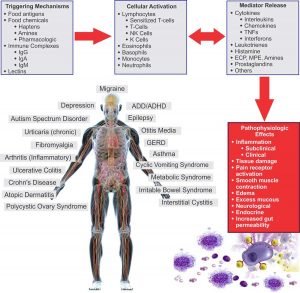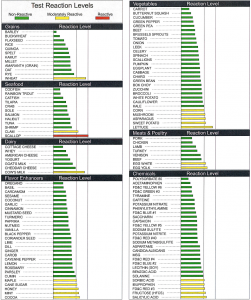Testing For Food Sensitivities
A little while ago I wrote a post about the difference between food allergies and food sensitivities.Simply put, people with food allergies KNOW that they have a reaction to certain foods (they may experience immediate symptoms like hives, shortness of breath etc).
What Causes Food Sensitivities
Food sensitivities are not as easy to detect as a food allergy. You see, food sensitivities develop over time and are often due to compromised digestion and/or a diet lacking in nutrients.A compromised digestive system can be due to a number of things. For example, when we are chronically stressed, our body produces less stomach acid and this can lead to an environment where things like yeast and "bad" bacteria can overgrow. (Stomach acid is GOOD for us - our stomach is supposed to be acidic so that it can kill bacteria, bugs and so that we can break down and assimilate nutrients).When the health of the gut is less than ideal, the mucousal barrier (basically the lining of our gut which keeps food particles and bacteria from leaking out into the blood stream) becomes permeable. This is where the term leaky gut comes from.Suddenly, food particles make their way into the blood stream and our antibodies start to attack the food particles, thinking they are foreign invaders and this is how food sensitivities develop.(Side note: Leaky gut has been linked not only to food sensitivities, but to auto-immune issues as well. Anecdotally, I have witnessed several clients, peers and friends heal themselves from auto-immune conditions by addressing gut health - there is also a ton of info on this if you do some research!).If you are struggling with unexplained symptoms OR some type of auto-immune condition, addressing gut health is a KEY part of the healing process, and it starts with figuring out what your food sensitivities are.The picture below describes how food sensitivities can cause inflammation. 
Why Food Sensitivities Are Hard to Detect Without a Test
The hard part about food sensitivities is that you may or may not notice the symptoms. The symptoms can vary from foggy thinking, to a rash to bloating to fatigue. And since there can be a delay in symptoms from the time that you eat the food, to the time you experience the symptoms - it can be hard to pinpoint exactly WHAT is causing you to feel a certain way.Not to mention - so many of us have succumbed to the idea that feeling "tired" and "bloated" on a regular basis is normal - it's not.
Why Elimination Diets Don't Work 100% of The Time
Maybe you've tried an elimination diet like Whole30, AIP or Paleo/Keto but still felt like crap. While these diets can be a GREAT place to start for most people, it doesn't help others for the simple fact that something as "healthy" and bland as an avocado could trigger YOUR body's immune response. Heck - on my food sensitivity test it came back that I was sensitive to LETTUCE!Check out my report bellow (red= most reactive, yellow= moderately reactive, green = OK!).
The MRT Test - The Best Food Sensitivity Test out there
I have taken a few different food sensitivity tests over the years, but none is more comprehensive and accurate than the MRT.In short, the MRT test tests for all END POINT immune responses where as most food sensitivity tests out there only test for specific antibodies. If you are into the nerdiness of it all, check out this paper (and corresponding research included) that was done on the MRT test. The MRT tests for 170 different items - check it out. This latest version tests eggs and egg whites separately which is something I was SUPER excited about (sadly I was sensitive to both😭) *Image used with permission from Now Leap - MRT.
*Image used with permission from Now Leap - MRT.
Will I Need To Give Up These Foods Forever?
The good news is that food sensitivities can often be addressed by doing an elimination protocol where the food items are avoided for 1-3 months. During this time, it's important to also do things to "heal & seal" the gut lining (adding things to your diet like grass fed butter, collagen, and bone broth and perhaps supplementing.)The MRT test is a service that I am happy to offer my clients, to learn more, please fill out the contact form on my website and get in touch! :)
How to Self Test Food Food Sensitivities Using the Cocoa's Pulse Test
While self testing for food sensitivities is not nearly as accurate as getting the MRT test, it can be a great place to start and can be done simply at home! This is a self test that I was taught when getting my certification as a Nutritional Therapy Practitioner and tests for allergic mention with food.Dr. Cocoa developed this test in the 1950s as a means to determine which foods cause stress to the body. You see, when the body is stressed the pulse will speed up - this can indicate an immune reaction or response to a food sensitivity or potential environmental allergen.Again, this method is not 100% accurate, but it is a simple way to begin to discover which foods you may be reactive to. Here is how to do it:
At Home Cocoa's Pulse Test
Step 1: Take your pulse for 1 full minute while you are in a relaxed state. Do not have anything to eat/drink/chew/smoke within 30 minutes.Step 2: Put a food item in mouth that you suspect you may have a sensitivity to and hold it in your mouth for at least 10-15 seconds. Do not eat it.Step 3: Record your pulse for 1 full minute with the food in your both.Step 4: Before recording another food item - make sure your pulse returns to normal. Rinse your mouth with water before testing another item.*If the pulse spikes more than 6 beats than the item is likely a sensitivity and the food should be avoided for 1-3 months while simultaneously doing heal and seal gut protocol.*The pulse must ALWAYS be taken for 1 full minute.
